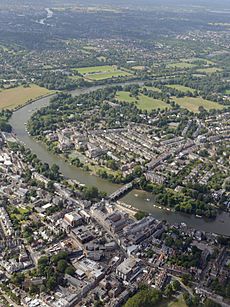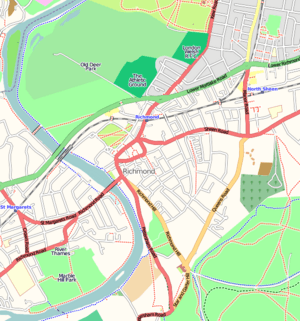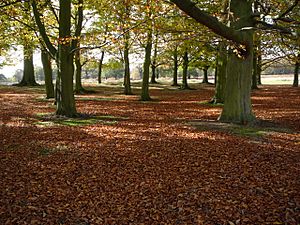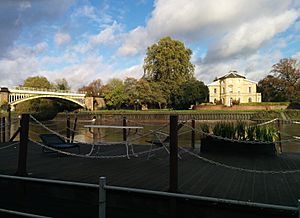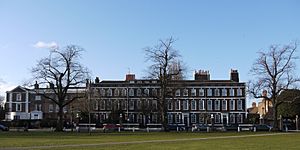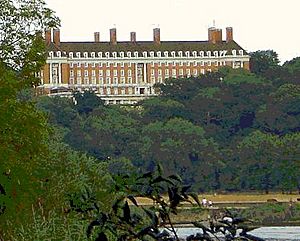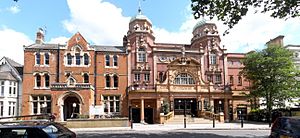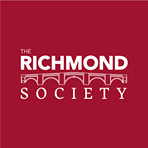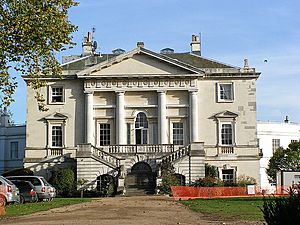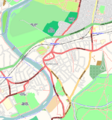Richmond, London facts for kids
Quick facts for kids Richmond |
|
|---|---|
 Richmond Riverside |
|
| Area | 5.38 km2 (2.08 sq mi) |
| Population | 21,469 (North Richmond and South Richmond wards 2011) |
| • Density | 3,991/km2 (10,340/sq mi) |
| OS grid reference | TQ1874 |
| • Charing Cross | 8.2 mi (13.2 km) ENE |
| London borough | |
| Ceremonial county | Greater London |
| Region | |
| Country | England |
| Sovereign state | United Kingdom |
| Post town | RICHMOND |
| Postcode district | TW9, TW10 |
| Dialling code | 020 |
| Police | Metropolitan |
| Fire | London |
| Ambulance | London |
| EU Parliament | London |
| UK Parliament |
|
| London Assembly |
|
Richmond is a town in south-west London, England. It is about 8 miles (13 km) west-southwest of Charing Cross, a central point in London. The town sits by the River Thames. It has many beautiful parks and open areas, including the famous Richmond Park. Many parts of Richmond, like Richmond Hill, are protected as special "conservation areas." This means their natural beauty and history are kept safe. There's even a special law from 1902 that protects the amazing view of the River Thames from Richmond Hill.
Richmond started when King Henry VII built Richmond Palace in the 1500s. He named the palace in 1501 after his family's old title, the Earl of Richmond, which came from a place in Richmond, North Yorkshire. The town then took the same name. Queen Elizabeth I loved Richmond and spent her last days at the palace. In the 1700s, Richmond Bridge was built to connect both sides of the Thames. Many beautiful Georgian-style houses were also built then, especially around Richmond Green and on Richmond Hill. Many of these old buildings are still standing and are protected because they are historically important. In 1846, the railway station opened, which helped Richmond become part of the growing city of London.
Richmond used to be part of the county of Surrey. In 1890, it became its own town council area, called a municipal borough. This area grew to include places like Kew and Ham. But in 1965, the way local government worked changed. Richmond became part of Greater London instead of Surrey. Since then, Richmond has been part of the London Borough of Richmond upon Thames. In 2011, about 21,469 people lived there. It's a busy place with many shops and businesses. Sometimes people mistakenly call the town "Richmond upon Thames," but that name actually refers to the larger London borough.
Contents
- History of Richmond
- How Richmond is Governed
- Richmond's Geography
- Richmond's Economy
- Fun Places to Visit in Richmond
- Local Societies
- Fun Things to Do in Richmond
- Education in Richmond
- People and Homes in Richmond
- Getting Around Richmond
- Hospitals Near Richmond
- Places of Worship
- Almshouses: Historic Homes
- Local Newspapers
- Famous People from Richmond
- Richmond as a Filming Location
- Images for kids
- See also
History of Richmond
How Richmond Got Its Name
Long ago, in the Middle Ages, this area was called Shene. The name "Sceon" was first written down in the 900s. You can still see this old name in nearby places like East Sheen and North Sheen. The land became owned by the royal family, and the main house was known as Sheen Palace. Most of it was destroyed by a fire in 1497.
King Henry VII rebuilt the palace. In 1501, he named it Richmond Palace. He chose this name to remember his family's old title, the Earl of Richmond, which came from a place in Yorkshire. The town that grew around the palace also took the name Richmond. For a while, people would use both names, like "Shene, also called Richemount."
Royal Homes in Richmond

King Henry I lived for a short time in the King's house in "Sheanes." In 1299, King Edward I brought his whole court to the manor house at Sheen. This made it a royal home. Later, King Edward III spent a lot of money making the manor house better. He died there in 1377.
King Richard II made Sheen his main home in 1383. But after his wife, Anne of Bohemia, died there, he was so sad that he ordered the house to be torn down. It was rebuilt between 1414 and 1422, but then another fire destroyed it in 1497.
After that fire, Henry VII built the new Richmond Palace. During Queen Elizabeth I's time, Shakespeare's acting group performed plays there. Queen Elizabeth loved Richmond and spent a lot of time there. She enjoyed hunting deer in the "Newe Parke of Richmonde," which is now called Old Deer Park. She passed away at the palace on March 24, 1603.
The palace was not used as a home after 1649. But in 1688, King James II had part of it rebuilt as a royal nursery for children. Most of the palace was ruined by 1779. However, some parts still stand today, like the Wardrobe, Trumpeters' House, and the Gate House, which was built in 1501.
Richmond's Growth in the 1700s and 1800s

Beyond the old palace grounds, Richmond was mostly farmland until the 1700s. White Lodge, located in what is now Richmond Park, was built as a hunting lodge for King George II. During this time, many large houses with their own land, like Asgill House and Pembroke Lodge, were built. More important houses, such as Downe House and Wick House, were built on Richmond Hill. This area became a very popular and fashionable place to live.
Richmond Bridge was finished in 1777. It replaced a ferry that used to carry people across the river between Richmond and East Twickenham. Today, this bridge and the well-kept Georgian houses around Richmond Green and on Richmond Hill are protected as historic buildings.
Richmond continued to grow and become richer in the 1800s. Many fancy houses were built on the streets along Richmond Hill. More shops also opened in the town center to serve the growing number of people. In 1892, Richmond started to get electricity, and by 1896, the town was wired up.
Richmond During the World Wars
Like many other towns in Britain, Richmond lost many young people in the First and Second World Wars. In the Second World War, 96 people died in air raids, and 297 houses were destroyed. The Richmond War Memorial was put up in 1921. It stands at the end of Whittaker Avenue, near the Old Town Hall and the river, to remember those who died in both wars.
How Richmond is Governed
Current Government
The town of Richmond is part of the London Borough of Richmond upon Thames. This borough is run by the Richmond upon Thames London Borough Council. In the most recent election in May 2022, the Liberal Democrats party stayed in charge of the council.
Richmond town is split into two areas for voting: North Richmond and South Richmond. North Richmond has three Liberal Democrat councillors. South Richmond has two Liberal Democrat councillors and one from the Green Party.
For the UK Parliament, Richmond town is part of the Richmond Park voting area. The person who represents this area in Parliament, called an MP, is Sarah Olney from the Liberal Democrats. She has been the MP since 2019. Richmond is also part of the South West area for the London Assembly. Nicholas Rogers from the Conservative Party has represented this area since 2021.
Past Government Changes
Richmond, which was once called Shene, used to be part of a large old parish called Kingston upon Thames in Surrey. Over time, it became its own parish, Richmond St Mary Magdalene. In 1890, this parish became the Municipal Borough of Richmond. The borough grew in 1892 to include Kew, Petersham, and part of Mortlake (North Sheen). In 1933, Ham was also added.
In 1965, the parish and municipal borough were ended by a law called the London Government Act 1963. This law moved Richmond from Surrey to Greater London. Richmond then joined with the old Municipal Borough of Twickenham and Municipal Borough of Barnes to form a new, larger borough: the London Borough of Richmond upon Thames.
Richmond's Geography
Richmond is across the river from East Twickenham. Even though it's technically on the south side of the River Thames, the river bends a lot here. So, the town is actually north and north-east of the closest part of the river. The Thames curves around Richmond and then around Kew.
The river at Richmond is still affected by the tides. To make sure boats can always travel, a special half-tide lock was opened in 1894. This lock, along with a weir (a small dam), makes sure the river is at least 5 feet 8 inches (1.73 meters) deep in the middle between Richmond and Teddington, no matter what the tide is doing. There's also a small footbridge above the lock and weir.
Richmond has many green and open spaces for everyone to enjoy. In the center of town is Richmond Green. It's a large, almost square grassy area. Together with the smaller Little Green, it covers about 12 acres (5 hectares). Roads go around the Green, and there's parking for people who live there and visitors. The south corner leads to the main shopping area. The west corner has the old gate house that leads to other parts of the old palace. The north corner has a path to Old Deer Park.
Old Deer Park is a huge 360-acre (1.5 km²) area of land owned by the Crown. It stretches from the town along the river to the Royal Botanic Gardens at Kew, which is a UNESCO World Heritage Site. This park has wide lawns and sports fields. It also has the old King's Observatory, built for King George III in 1769. The town's main shopping street, George Street, is also named after this king.
The town center is about 33 feet (10 meters) above sea level. South of the town center, Richmond Hill rises from Richmond Bridge to about 165 feet (50 meters) high. Just past the top of Richmond Hill is Richmond Park. This park is 2,360 acres (9.55 km²) of wild heath and woodland. It was first created for hunting and is now London's largest royal park.
Richmond Park is a national nature reserve, a Site of Special Scientific Interest, and a Special Area of Conservation. It's also listed as a very important historic park. King Charles I created it as a deer park in 1634. Today, about 630 red and fallow deer roam freely through most of the park. The park has several gates for cars and people, leading to nearby areas like Sheen, Roehampton, Putney, Kingston, and Ham.
Nearby Places
- Barnes
- Brentford
- East Sheen
- Ham
- Hampton
- Hounslow
- Isleworth
- Kew
- Kingston
- Mortlake
- Petersham
- Roehampton
- St Margarets
- Strawberry Hill
- Teddington
- Twickenham
- Whitton
- Wimbledon
Richmond's Economy
The London Borough of Richmond upon Thames, which includes Richmond town, has the lowest poverty rate in London. Richmond town has the biggest business area in the borough. It's known as a popular place for shopping, especially for higher-end items. The town center has about 50,000 square meters of shops, mainly on George Street, The Quadrant, and Hill Street. Most of these are well-known chain stores like Marks & Spencer, Boots, Tesco Metro, and Waitrose.
Smaller, independent shops are found in the narrow paths leading from George Street towards Richmond Green and up Richmond Hill. There's also a farmers' market in Heron Square on Saturdays. Richmond has one large Sainsbury's supermarket with parking for 420 cars, located east of the town near North Sheen railway station.
You can find many convenience stores, restaurants, and cafes on Richmond Hill along Friars Stile Road. There are also places along Kew Road towards the Botanical Gardens and on Sheen Road.
Richmond also has many offices and is the UK or European headquarters for several big international companies. These include eBay, PayPal, and The Securitas Group. Many national, regional, and local businesses also have their main offices here. London's Evening Standard newspaper has called Richmond "the beating heart of London's growing technology industry."
Fun Places to Visit in Richmond
Richmond Riverside: By the River Thames
The Thames river adds a lot to Richmond's charm. The area around Richmond Bridge has many bars and restaurants. The look of Richmond Riverside, with its old-style buildings, was designed by architect Quinlan Terry in the 1980s. In the river itself, you can see the green Corporation Island and the two small Flowerpot Islands.
A path along the Thames lets you walk past homes, pubs, and open areas. You can also find various small greens, lanes, and footpaths through Richmond. The part of the Thames below Richmond Hill is called Horse Reach and includes Glover's Island. There are towpaths on both sides of the river, which are popular for walking, jogging, and cycling. Boats from the Westminster Passenger Services Association travel daily between Kew and Hampton Court Palace, stopping at Richmond.
Richmond Green: A Historic Open Space

Richmond Green is often called "one of the most beautiful urban greens anywhere in England." It's shaped like a square, with open grass and tall trees, covering about 12 acres (5 hectares). On sunny weekends and holidays, many people come to the Green. It has a long history of sports. Since the 1500s, tournaments and archery contests have happened here. Cricket matches have been played since the mid-1700s and still happen today.
To the west of the Green is Old Palace Lane. This is one of Richmond's oldest roads. It used to be a path from the river, where goods were loaded, to the back entrance of Richmond Palace. Next to it are the famous houses called Maids of Honour Row. These three-story houses were built in 1724 for the "maids of honour" (royal servants) of Queen Caroline, who was married to King George II. The famous explorer Richard Burton lived at No. 2 when he was a child.
Today, the north, west, and south sides of the Green have homes. The east side, which connects to George Street, has shops and businesses. Pubs and cafes are found near Paved Court and Golden Court. These are small paths that lead from the Green to the main shopping street, George Street. These paths are lined with many unique, privately owned boutiques.
Richmond Hill: A Viewpoint with History
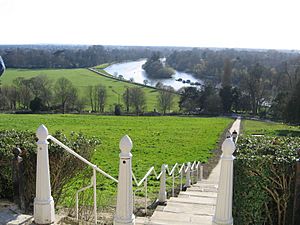

Partway up Richmond Hill is the Poppy Factory. This factory mainly employs disabled former soldiers and women. They make the remembrance poppies that are sold every November for Remembrance Day.
The view from the top of Richmond Hill, looking west towards Windsor, has been famous for a long time. It has inspired paintings by famous artists like J. M. W. Turner and Sir Joshua Reynolds, and also poetry. A grand description of the view is in Sir Walter Scott's novel The Heart of Midlothian (1818). It's a common mistake to think the song "Lass of Richmond Hill" is about this hill. The young woman in the song actually lived in Hill House in Richmond, North Yorkshire.
Except for the big rugby stadium at Twickenham and planes landing at Heathrow, the view has not changed much in 200 years. The view from Richmond Hill is now part of a plan to protect and improve this part of the river area in London.
A wide, gravel path runs along the top of the hill, set back from the road. It has benches and information boards that tell visitors about interesting places. Sloping down to the River Thames are the Terrace Gardens. These gardens were first created in the 1880s and later extended all the way to the river.
A large building on the hill is the former Royal Star and Garter Home. This building was sold in the 2010s and turned into apartments. During World War I, an old hotel on this spot was used as a military hospital. After the war, a new building was built to care for 180 seriously injured soldiers. This building was sold in 2013 because it no longer met modern needs. The charity moved its residents to a new building in Surbiton.
Richmond Park: London's Largest Royal Park
At the top of Richmond Hill, across from the old Royal Star and Garter Home, is the Richmond Gate entrance to Richmond Park. The park is a national nature reserve, a Site of Special Scientific Interest, and a Special Area of Conservation. It is the largest of London's Royal Parks. King Charles I created it in 1634 as a deer park. Today, it has over 600 red and fallow deer that roam freely. Richmond Gate is open to cars from dawn until dusk.
King Henry's Mound is the highest point in the park. It's an ancient Neolithic burial mound. From here, you can see a protected view of St Paul's Cathedral in the City of London, which is over 10 miles (16 km) to the east. This view has been protected since 1710. People sometimes connect the mound's name to King Henry VIII or his father, Henry VII. However, there's no proof for the story that Henry VIII stood on the mound to watch for a signal from St Paul's that Anne Boleyn had been executed.
King Henry's Mound is on the grounds of Pembroke Lodge. This house became the home of the Prime Minister, Lord John Russell, in 1847. He did a lot of government work there and hosted important people like Queen Victoria, other royal families, writers, and Giuseppe Garibaldi. Later, it was the childhood home of Lord John Russell's grandson, the famous philosopher Bertrand Russell. Today, it's a popular restaurant with great views of the Thames Valley.
White Lodge was built as a hunting lodge for King George II and finished in 1730. Many famous people have lived there, including members of the Royal Family. The future King Edward VIII was born at White Lodge in 1894. His brother, Prince Albert (who became King George VI), and his wife, the Duchess of York, lived there in the 1920s. Since 1955, the Royal Ballet School has been based at the lodge, where young ballet students learn to dance.
Another royal home in the park is Thatched House Lodge. Since 1963, it has been the home of Princess Alexandra, The Honourable Lady Ogilvy, who is a cousin of Queen Elizabeth II. General Dwight D Eisenhower, who later became President of the United States, lived there during the Second World War.
Museums and Art Galleries

The Museum of Richmond is in Richmond's Old Town Hall, near Richmond Bridge. It has exhibits about the history of Richmond, Ham, Petersham, and Kew. It also has changing exhibits, educational activities, and events. Some special items in the museum include 16th-century glass from Richmond Palace and a painting called The Terrace and View from Richmond Hill, Surrey by the Dutch artist Leonard Knyff. It's free to enter the museum.
The Riverside Gallery, also in the Old Town Hall, shows temporary exhibits by local artists. These include paintings, prints, and photos. Admission is free here too.
Theatres and Cinemas
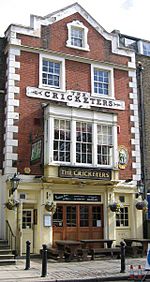
Richmond has two theatres. Richmond Theatre on Little Green is an old Victorian building. It was designed by Frank Matcham and later updated in 1990. The theatre has a weekly schedule of plays and musicals, often performed by professional touring groups. Sometimes, you can even see shows before they go to London's West End. Around Christmas and New Year, they have a traditional pantomime show. Many famous British performers have appeared here.
Near Richmond railway station is the Orange Tree Theatre. It started in 1971 in a room above the Orange Tree pub. As more people came to see shows, they needed a bigger space. In 1991, the theatre moved to its current home in a converted primary school. This 172-seat theatre was built especially for "theatre in the round," where the audience sits all around the stage. The Orange Tree Theatre is known for its high-quality shows, including new plays and forgotten old classics.
The town has two cinemas. The arthouse Curzon cinema is in Water Lane. There's also an Odeon cinema with seven screens in two locations. The front of one Odeon building is the only high street building you can see from Richmond Bridge. The other screens are nearby in Red Lion Street. The Odeon on Hill Street, built in 1930, has an Art Deco style and is a protected building.
Historic Pubs
Richmond has many pubs and bars in its town center, along the river, and up the hill. There's something for everyone! One of the oldest is The Cricketers, which has been serving drinks since 1770. The original building burned down in 1844, but the current building quickly replaced it. Samuel Whitbread, who started the Whitbread Brewery, partly owned it. Other pubs that are protected as historic buildings include the White Cross, the Old Ship, and the Britannia.
Restaurants and Cafes
You can find many popular restaurant chains within 500 meters of Richmond Bridge. There are also many privately owned restaurants offering food from all over the world, including French, German, Indian, Japanese, Korean, Russian, Spanish, and Thai dishes.
The Bingham Riverhouse hotel, which overlooks the Thames, received its first Michelin star in 2010. It's in a protected building that dates back to about 1760.
Local Societies
 |
|
| Abbreviation | RLHS |
|---|---|
| Formation | 1985 |
| Founder | John Cloake |
| Legal status | registered charity (number 292907) |
|
Region served
|
Richmond, Kew, Petersham and Ham |
|
Membership
|
400 |
|
Chair
|
Dr Simon Targett |
|
Main organ
|
Richmond History (journal); The Richmond Local History Society Members' Newsletter (three times a year) |
|
Budget
|
<£8,000 |
|
Staff
|
none |
|
||||||||||||||||||||
The Richmond Local History Society studies the history of Richmond, Kew, Petersham, and Ham. It holds talks about history and arranges visits to old buildings. The Society publishes a newsletter three times a year and a journal called Richmond History.
The Richmond Society is a civic society and conservation group. It was started in 1957 by local people who wanted to protect Richmond's environment. For example, they fought against putting modern streetlights around Richmond Green. The Society works to keep Richmond's natural and built areas safe. It also watches new building plans and gives awards for projects that improve Richmond. They also organize meetings, guided walks, and publish a quarterly newsletter.
Fun Things to Do in Richmond
Richmond has many green spaces, making it a great place for fun activities.
Boating on the Thames
You can rent skiffs (boats with fixed seats) by the hour from local boat builders near the bridge. You can row upstream towards historic homes like Ham House and Marble Hill House. The Richmond Canoe Club, started in 1944, is Britain's largest canoe club. It's also on the path south of Richmond Bridge.
Cycling Paths
Richmond is part of the London Cycle Network. This means it has bike paths both on and off roads throughout the area. You can cycle along the Thames towpath and in Richmond Park.
Horse Riding and Polo

Richmond Park has special paths for horses, called bridle paths. You can rent horses from several stables around the edge of the park.
Ham Polo Club is on Petersham Road, at the bottom of Richmond Hill. This club started in 1926 and is the only polo club in London. It's a popular spot for picnics during the summer.
Field Sports and Games
Old Deer Park has open areas for recreation, football, rugby, and other sports fields. It also has a leisure center called Pools on the Park, run by the local council. This center has 33-meter indoor and outdoor pools and a fitness center. The park also includes the Royal Mid-Surrey Golf Club with golf and pitch and putt courses. The Richmond Athletic Ground is home to the Richmond F.C. and London Scottish rugby clubs. Another sports ground hosts the Richmond Cricket Club and the London Welsh Rugby Union club. It also has tennis courts and a bowling green.
The Prince's Head Cricket Club plays matches on Richmond Green throughout the summer.
Running Events
5K Parkrun events happen every Saturday morning at Old Deer Park and Richmond Park.
Education in Richmond
Richmond has many schools and colleges. You can find a full list at List of schools and colleges in Richmond upon Thames.
People and Homes in Richmond
| Ward | Detached | Semi-detached | Terraced | Flats and apartments |
Caravans/temporary/ mobile homes/houseboats |
Shared between households |
|---|---|---|---|---|---|---|
| North Richmond | 142 | 1,093 | 1,546 | 1,963 | 0 | 27 |
| South Richmond | 384 | 653 | 1,092 | 2,995 | 0 | 44 |
| Ward | Population | Households | % Owned outright | % Owned with a loan | Area (hectares) |
|---|---|---|---|---|---|
| North Richmond | 10,649 | 5,168 | 26 | 30 | 272 |
| South Richmond | 10,820 | 4,047 | 28 | 24 | 266 |
German Residents in Richmond
Richmond and the borough of Richmond have been popular places for German people to live since the 1800s. Sir Max Waechter, a businessman born in Germany who lived in Richmond, gave Glover's Island to the local council in 1900. The German School London opened in nearby Petersham in 1971. This has continued to make Richmond a popular choice for German families moving to London.
Getting Around Richmond
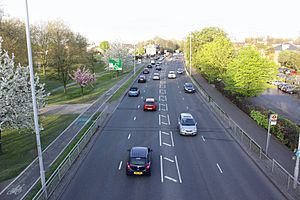
About 30% of homes in Richmond do not have a car or van. This is higher than the borough average of 24%. This might be because Richmond has great public transport. Half of the homes have one car, which is similar to the borough average.
Tube and Train Services
- Richmond station is a major transport hub.
- The District line (part of the London Underground) goes towards Kew Gardens and Upminster.
- London Overground trains go towards Kew Gardens, Willesden Junction, and Stratford.
- Mainline trains from Waterloo to Reading line and other branch lines stop at Richmond station. These go towards Windsor and Weybridge. One service also stops at Richmond on its way back to central London via Kingston upon Thames.
- North Sheen station also has trains on the Waterloo to Reading line.
Bus Services
Richmond is served by many Transport for London bus routes.
Roads in Richmond
Richmond's main road is the A316. It runs between Chiswick and the M3 motorway. This road cuts through Old Deer Park and the town to its north. It was built in the 1930s and is the town's only dual carriageway (a road with two lanes in each direction). This road separated Richmond from Kew and required the building of Twickenham Bridge. West of Richmond, this road expands to three lanes and then becomes a motorway.
The town center is on the A307. This used to be the main road connecting London and north-west Surrey. It was also one of the main routes of the Portsmouth Road before that road was changed. The town center is also on the A305, which runs from East Sheen and crosses Richmond Bridge to Twickenham.
Hospitals Near Richmond
- Richmond Royal Hospital, on Kew Foot Road in Richmond, used to be a hospital for mental health. It is now being turned into apartments, but a part of it still helps people.
- Queen Mary's Hospital, Roehampton is a local hospital in Roehampton.
The closest main hospitals, which have emergency rooms and maternity units for babies, are:
- Kingston Hospital in Kingston upon Thames.
- West Middlesex Hospital in Isleworth.
Places of Worship
| Name | Type of Church/Religion | Address | Website | Image |
|---|---|---|---|---|
| Bethlehem Chapel, Richmond | Independent Calvinist | Church Terrace, Richmond TW10 6SE | website |  |
| Christian Fellowship in Richmond | Evangelical Alliance | Halford House, 27 Halford Road, Richmond TW10 6AW | website | |
| Duke Street Church, Richmond | Conservative Evangelicalism | Duke Street, Richmond TW9 1DH | website |  |
| Ebenezer Strict Baptist Chapel, Richmond | Strict Baptist | 17 Jocelyn Road, Richmond TW9 2TJ |  |
|
| First Church of Christ, Scientist, Richmond | Christian Science | 35 Sheen Road, Richmond TW9 1AD | website |  |
| Friends Meeting House, Richmond | Quakers | 1 Retreat Road, Richmond TW9 1NN | website | |
| Holy Trinity, Richmond | Church of England | Sheen Park, Richmond TW9 1UP | website |  |
| Our Lady Queen of Peace Church, Richmond | Roman Catholic | 222 Sheen Road, Richmond TW10 5AN | website |  |
| Raleigh Road United Church | Methodist & United Reformed | Raleigh Road, Richmond TW9 2DX | website |  |
| Richmond and Putney Unitarian Church | Unitarian | Ormond Road, Richmond TW10 6TH | website |  |
| Richmond Synagogue | Orthodox Judaism | Lichfield Gardens, Richmond TW9 1AP | website | |
| St Elizabeth of Portugal Church | Roman Catholic | The Vineyard, Richmond TW10 6AQ | website |  |
| Chapel of St Francis, Hickey's Almshouses | Church of England | Sheen Road, Richmond TW9 1XB |  |
|
| St John the Divine, Richmond | Church of England | Kew Road, Richmond TW9 2TN | website |  |
| St Mary Magdalene, Richmond | Church of England | Red Lion Street, Richmond TW9 1RE | website |  |
| St Matthias Church, Richmond | Church of England | Friars Stile Road, Richmond TW10 6PN | website |  |
| The Vineyard Life Church, Richmond | Evangelical Alliance | The Vineyard, Richmond TW10 6AQ | website |  |
Almshouses: Historic Homes
Richmond has eight groups of almshouses. These are special homes, often for older or poorer people. Six of them are very old and historically important. Some were built in the 1500s. All of them are managed by The Richmond Charities. This charity also looks after other almshouses in nearby towns like Twickenham and East Sheen.
| Name | Location | Number of homes |
History | Image |
|---|---|---|---|---|
| Bishop Duppa's Almshouses | The Vineyard | 10 | These homes were first built in 1661 by Brian Duppa, who was the Bishop of Winchester. They were rebuilt in 1851 at their current location and are now protected as historic buildings. |  |
| Church Estate Almshouses | Sheen Road | 10 | Most of these buildings were designed by William Crawford Stow and built in 1843. They are now protected as historic buildings. The charity that built them existed even in Queen Elizabeth I's time, so it's very old! |  |
| Hickey's Almshouses | Between Sheen Road and St Mary's Grove | 50 | William Hickey, who died in 1727, left money from his properties to provide homes for six men and ten women. In 1822, Elizabeth Doughty gave a large donation, which helped a lot. Twenty homes, designed by Lewis Vulliamy, along with a chapel and two gate lodges, were built in 1834. These are very important historic buildings. The property now has 49 flats and cottages. |  |
| Houblon's Almshouses | Worple Way | 11 | These homes were started in 1757 by Rebecca and Susanna Houblon, who built nine of them. Two more were added in 1857. They are now protected as historic buildings. |  |
| Michel's Almshouses | The Vineyard | 17 | These were founded in the 1600s by Humphrey Michel. The first ten homes were built in 1696 and rebuilt in 1811. Six more were added in 1858. They are protected as historic buildings. |  |
| Queen Elizabeth's Almshouses | The Vineyard | 4 | Sir George Wright founded these in 1600 (during Queen Elizabeth I's reign) to house eight older women. They were first built on Petersham Road. By 1767, they were falling apart. In 1767, William Turner rebuilt them on his land in The Vineyard, with money raised from the public. They were rebuilt again in 1857. After being damaged in World War II, they were replaced with four new houses in 1955. |  |
A seventh group of almshouses, Benn's Walk (now with five homes), was built in 1983.
An eighth group of almshouses is 10–18 Manning Place (with nine homes), just off Queen's Road. This property was built in 1993 and bought by The Richmond Charities in 2017.
Local Newspapers
The Richmond and Twickenham Times newspaper has been published since 1873. The Twickenham & Richmond Tribune, an online newspaper, has been published weekly since 2016.
Famous People from Richmond
For many centuries, the royal family lived in Richmond. The town also has a long list of other famous people who have lived there, both in the past and present.
- List of current and former residents of Richmond upon Thames
Richmond as a Filming Location
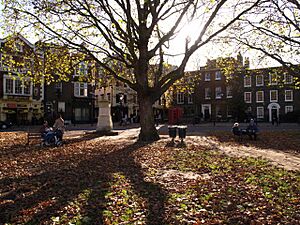
Richmond is a popular place for filming movies and TV shows. Richmond Green, with its old buildings and paved paths, is often used to create scenes of old city squares or townhouses. For example, The Crimson Petal and the White (2011) and Downton Abbey (2014) were filmed there. Many other films and TV shows have featured The Green or Little Green, including Agatha Christie's Poirot, Simon Schama's Power of Art, and Peter Rabbit 2.
The TV comedy series Ted Lasso (2020-2023) is set in Richmond. Many scenes are filmed on The Green. Ted Lasso and other characters are shown drinking at the Prince's Head pub (which was renamed The Crown and Anchor for the show). Ted also lives at a fictional address, 9½ Paved Court (actually No. 11A).
Richmond Theatre is also a major filming spot. It has appeared in movies like The Naked Truth (1957), Bugsy Malone (1976), The Krays (1990), Evita (1996), Bedazzled (2000), The Hours (2002), Finding Neverland (2004), and The Wolfman (2010).
Richmond Park in Movies and TV
Richmond Park has been featured in many films and TV series.
- In the film The Titfield Thunderbolt (1955), a train runs through the park and crashes into a tree.
- In the 1968 film Performance, James Fox drives a Rolls-Royce car across Richmond Park.
- The park was the setting for the historical film Anne of the Thousand Days (1969), starring Richard Burton and Geneviève Bujold. This film shows Richmond Park in the 1500s and tells the story of King Henry VIII and Anne Boleyn.
- An Indian dust storm was filmed in the park for the movie Heat and Dust (1983).
- The Royal Ballet School in Richmond Park was shown in the film Billy Elliot (2000).
- In 2010, director Guy Ritchie filmed parts of Sherlock Holmes: A Game of Shadows (2011) in the park with Robert Downey Jr. and Jude Law.
- Some scenes from Into the Woods (2014), a Disney fantasy film with Meryl Streep, were filmed in the park.
Besides movies, Richmond Park is often seen in TV shows, company videos, and fashion shoots. It has appeared on Blue Peter, Inside Out (a BBC news program), and BBC Springwatch. In 2014, it was featured in a video for The Hearsum Collection. In 2017, it was in a TV film narrated by David Attenborough, made by the Friends of Richmond Park.
Images for kids
See also
 In Spanish: Richmond (Londres) para niños
In Spanish: Richmond (Londres) para niños




